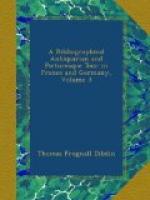The plants are on one side of the leaf, the text is on the other. The former are, upon the whole, delicately and naturally coloured. At the end, there is an ornithological treatise, which is very curious for the colouring of the birds. This latter treatise is written in a smaller Greek capital letter than the first; but M. Kopitar supposes it to be as ancient. We know from an indisputably coeval date, that this precious MS. was executed by order of the Empress Juliana Anicia in the year of Christ 505. There is a smaller MS. of Dioscorides, of a more recent date, in which the plants are coloured, and executed—one, two, or three, in number—upon the rectos of the leaves, with the text below, in two columns. Both the illuminations and the text are of inferior execution to those of the preceding MS. Montfaucon, who never saw the larger, makes much of the smaller MS.; which scarcely deserves comparison with it.
PHILOSTRATUS; Lat. This is the MS. which belonged to Matthias Corvinus—and of which the illuminations are so beautiful, that Nesselius has thought it worth while to give a fac-simile of the first—from whence I gave a portion to the public in the Bibliog. Decameron.[115] I think that I may safely affirm, that the two illuminations, which face each other at the beginning, are the finest, in every respect, which I have seen of that period; but they have been sadly damaged. The two or three other illuminations, by different hands, are much inferior. The vellum and writing are equally charming.
VALERIUS MAXIMUS. This copy has the name of Sambucus at the bottom of the first illumination, and was doubtless formerly in the collection of Matthias Corvinus—the principal remains of whose magnificent library (although fewer than I had anticipated) are preserved in this collection. The illumination in the MS. just mentioned, is very elegant and pleasing; but the colours are rather too dark and heavy. The intended portrait of the Roman historian, with the arms and supporters below, are in excellent good taste. The initial letters and the vellum are quite delightful. The scription is very good.
LIVIUS: in six folio volumes. We have here a beautiful and magnificent MS. in a fine state of preservation. There is only one illumination in each volume; but that “one” is perhaps the most perfect specimen which can be seen of that open, undulating, arabesque kind of border, which is rather common in print as well as in MS., towards the end of the fifteenth century. These six illuminations, for invention, delicacy, and brilliancy of finish, are infinitely beyond any thing of the kind which I have seen. The vellum is perfectly beautiful. To state which of these illuminations is the most attractive, would be a difficult task; but if you were at my elbow, I should direct your particular attention to that at the beginning of the IXth book of the IVth Decad—especially to the opposite ornament; where two green fishes unite round a circle of gold, with the title, in golden capitals, in the centre. O Matthias Corvinus, thou wert surely the EMPEROR of Book Collectors!




